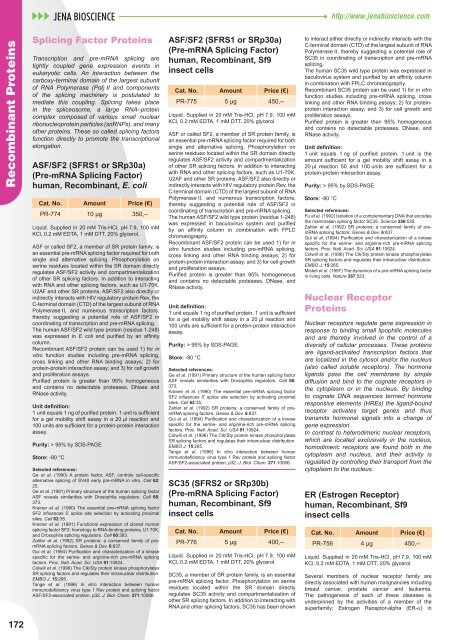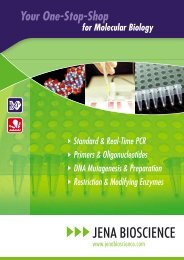Nucleotide Analogs - Jena Bioscience
Nucleotide Analogs - Jena Bioscience
Nucleotide Analogs - Jena Bioscience
Create successful ePaper yourself
Turn your PDF publications into a flip-book with our unique Google optimized e-Paper software.
Recombinant Proteins<br />
172<br />
Splicing Factor Proteins<br />
Transcription and pre-mRNA splicing are<br />
tightly coupled gene expression events in<br />
eukaryotic cells. An interaction between the<br />
carboxy-terminal domain of the largest subunit<br />
of RNA Polymerase (Pol) II and components<br />
of the splicing machinery is postulated to<br />
mediate this coupling. Splicing takes place<br />
in the spliceosome, a large RNA–protein<br />
complex composed of various small nuclear<br />
ribonucleoprotein particles (snRNPs), and many<br />
other proteins. These so called splicing factors<br />
function directly to promote the transcriptional<br />
elongation.<br />
ASF/SF2 (SFRS1 or SRp30a)<br />
(Pre-mRNA Splicing Factor)<br />
human, Recombinant, E. coli<br />
Cat. No. Amount Price (€)<br />
PR-774 10 µg 350,--<br />
Liquid. Supplied in 20 mM Tris-HCl, pH 7.9, 100 mM<br />
KCl, 0.2 mM EDTA, 1 mM DTT, 20% glycerol.<br />
ASF or called SF2, a member of SR protein family, is<br />
an essential pre-mRNA splicing factor required for both<br />
single and alternative splicing. Phosphorylation on<br />
serine residues located within the SR domain directly<br />
regulates ASF/SF2 activity and compartmentalization<br />
of other SR splicing factors. In addition to interacting<br />
with RNA and other splicing factors, such as U1-70K,<br />
U2AF and other SR proteins, ASF/SF2 also directly or<br />
indirectly interacts with HIV regulatory protein Rev, the<br />
C-terminal domain (CTD) of the largest subunit of RNA<br />
Polymerase II, and numerous transcription factors,<br />
thereby suggesting a potential role of ASF/SF2 in<br />
coordinating of transcription and pre-mRNA splicing.<br />
The human ASF/SF2 wild type protein (residue 1-248)<br />
was expressed in E. coli and purifi ed by an affi nity<br />
column.<br />
Recombinant ASF/SF2 protein can be used 1) for in<br />
vitro function studies including pre-mRNA splicing,<br />
cross linking and other RNA binding assays; 2) for<br />
protein-protein interaction assay; and 3) for cell growth<br />
and proliferation assays.<br />
Purifi ed protein is greater than 95% homogeneous<br />
and contains no detectable proteases, DNase and<br />
RNase activity.<br />
Unit defi nition:<br />
1 unit equals 1 ng of purifi ed protein. 1 unit is suffi cient<br />
for a gel mobility shift assay in a 20 µl reaction and<br />
100 units are suffi cient for a protein-protein interaction<br />
assay.<br />
Purity: > 95% by SDS-PAGE.<br />
Store: -80 °C<br />
Selected references:<br />
Ge et al. (1990) A protein factor, ASF, controls cell-specifi c<br />
alternative splicing of SV40 early pre-mRNA in vitro. Cell 62:<br />
25.<br />
Ge et al. (1991) Primary structure of the human splicing factor<br />
ASF reveals similarities with Drosophila regulators. Cell 66:<br />
373.<br />
Krainer et al. (1990) The essential pre-mRNA splicing factor<br />
SF2 infl uences 5’ splice site selection by activating proximal<br />
sites. Cell 62:35.<br />
Krainer et al. (1991) Functional expression of cloned human<br />
splicing factor SF2: homology to RNA-binding proteins, U1 70K,<br />
and Drosophila splicing regulators. Cell 66:383.<br />
Zahler et al. (1992) SR proteins: a conserved family of premRNA<br />
splicing factors. Genes & Dev. 6:837.<br />
Gui et al. (1994) Purifi cation and characterization of a kinase<br />
specifi c for the serine- and arginine-rich pre-mRNA splicing<br />
factors. Proc. Natl. Acad. Sci. USA 91:10824.<br />
Colwill et al. (1996) The Clk/Sty protein kinase phosphorylates<br />
SR splicing factors and regulates their intranuclear distribution.<br />
EMBO J. 15:265.<br />
Tange et al. (1996) In vitro interaction between human<br />
immunodefi ciency virus type 1 Rev protein and splicing factor<br />
ASF/SF2-associated protein, p32. J. Biol. Chem. 271:10066.<br />
ASF/SF2 (SFRS1 or SRp30a)<br />
(Pre-mRNA Splicing Factor)<br />
human, Recombinant, Sf9<br />
insect cells<br />
Cat. No. Amount Price (€)<br />
PR-775 5 µg 450,--<br />
Liquid. Supplied in 20 mM Tris-HCl, pH 7.9, 100 mM<br />
KCl, 0.2 mM EDTA, 1 mM DTT, 20% glycerol.<br />
ASF or called SF2, a member of SR protein family, is<br />
an essential pre-mRNA splicing factor required for both<br />
single and alternative splicing. Phosphorylation on<br />
serine residues located within the SR domain directly<br />
regulates ASF/SF2 activity and compartmentalization<br />
of other SR splicing factors. In addition to interacting<br />
with RNA and other splicing factors, such as U1-70K,<br />
U2AF and other SR proteins, ASF/SF2 also directly or<br />
indirectly interacts with HIV regulatory protein Rev, the<br />
C-terminal domain (CTD) of the largest subunit of RNA<br />
Polymerase II, and numerous transcription factors,<br />
thereby suggesting a potential role of ASF/SF2 in<br />
coordinating of transcription and pre-mRNA splicing.<br />
The human ASF/SF2 wild type protein (residue 1-248)<br />
was expressed in baculovirus system and purifi ed<br />
by an affi nity column in combination with FPLC<br />
chromatography.<br />
Recombinant ASF/SF2 protein can be used 1) for in<br />
vitro function studies including pre-mRNA splicing,<br />
cross linking and other RNA binding assays; 2) for<br />
protein-protein interaction assay; and 3) for cell growth<br />
and proliferation assays.<br />
Purifi ed protein is greater than 95% homogeneous<br />
and contains no detectable proteases, DNase, and<br />
RNase activity.<br />
Unit defi nition:<br />
1 unit equals 1 ng of purifi ed protein. 1 unit is suffi cient<br />
for a gel mobility shift assay in a 20 µl reaction and<br />
100 units are suffi cient for a protein-protein interaction<br />
assay.<br />
Purity: > 95% by SDS-PAGE.<br />
Store: -80 °C<br />
Selected references:<br />
Ge et al. (1991) Primary structure of the human splicing factor<br />
ASF reveals similarities with Drosophila regulators. Cell 66:<br />
373.<br />
Krainer et al. (1990) The essential pre-mRNA splicing factor<br />
SF2 infl uences 5’ splice site selection by activating proximal<br />
sites. Cell 62:35.<br />
Zahler et al. (1992) SR proteins: a conserved family of premRNA<br />
splicing factors. Genes & Dev. 6:837.<br />
Gui et al. (1994) Purifi cation and characterization of a kinase<br />
specifi c for the serine- and arginine-rich pre-mRNA splicing<br />
factors. Proc. Natl. Acad. Sci. USA 91:10824.<br />
Colwill et al. (1996) The Clk/Sty protein kinase phosphorylates<br />
SR splicing factors and regulates their intranuclear distribution.<br />
EMBO J. 15:265.<br />
Tange et al. (1996) In vitro interaction between human<br />
immunodefi ciency virus type 1 Rev protein and splicing factor<br />
ASF/SF2-associated protein, p32. J. Biol. Chem. 271:10066.<br />
SC35 (SFRS2 or SRp30b)<br />
(Pre-mRNA Splicing Factor)<br />
human, Recombinant, Sf9<br />
insect cells<br />
Cat. No. Amount Price (€)<br />
PR-776 5 µg 400,--<br />
Liquid. Supplied in 20 mM Tris-HCl, pH 7.9, 100 mM<br />
KCl, 0.2 mM EDTA, 1 mM DTT, 20% glycerol.<br />
SC35, a member of SR protein family, is an essential<br />
pre-mRNA splicing factor. Phosphorylation on serine<br />
residues located within the SR domain directly<br />
regulates SC35 activity and compartmentalization of<br />
other SR splicing factors. In addition to interacting with<br />
RNA and other splicing factors, SC35 has been shown<br />
http://www.jenabioscience.com<br />
to interact either directly or indirectly interacts with the<br />
C-terminal domain (CTD) of the largest subunit of RNA<br />
Polymerase II, thereby suggesting a potential role of<br />
SC35 in coordinating of transcription and pre-mRNA<br />
splicing.<br />
The human SC35 wild type protein was expressed in<br />
baculovirus system and purifi ed by an affi nity column<br />
in combination with FPLC chromatography.<br />
Recombinant SC35 protein can be used 1) for in vitro<br />
function studies including pre-mRNA splicing, cross<br />
linking and other RNA binding assays; 2) for proteinprotein<br />
interaction assay; and 3) for cell growth and<br />
proliferation assays.<br />
Purifi ed protein is greater than 95% homogeneous<br />
and contains no detectable proteases, DNase, and<br />
RNase activity.<br />
Unit defi nition:<br />
1 unit equals 1 ng of purifi ed protein. 1 unit is the<br />
amount suffi cient for a gel mobility shift assay in a<br />
20 µl reaction 50 and 100 units are suffi cient for a<br />
protein-protein interaction assay.<br />
Purity: > 95% by SDS-PAGE.<br />
Store: -80 °C<br />
Selected references:<br />
Fu et al. (1992) Isolation of a complementary DNA that encodes<br />
the mammalian splicing factor SC35. Science 256:535.<br />
Zahler et al. (1992) SR proteins: a conserved family of premRNA<br />
splicing factors. Genes & Dev. 6:837.<br />
Gui et al. (1994) Purifi cation and characterization of a kinase<br />
specifi c for the serine- and arginine-rich pre-mRNA splicing<br />
factors. Proc. Natl. Acad. Sci. USA 91:10824.<br />
Colwill et al. (1996) The Clk/Sty protein kinase phosphorylates<br />
SR splicing factors and regulates their intranuclear distribution.<br />
EMBO J. 15:265.<br />
Misteli et al. (1997) The dynamics of a pre-mRNA splicing factor<br />
in living cells. Nature 387:523.<br />
Nuclear Receptor<br />
Proteins<br />
Nuclear receptors regulate gene expression in<br />
response to binding small lipophilic molecules<br />
and are thereby involved in the control of a<br />
diversity of cellular processes. These proteins<br />
are ligand-activated transcription factors that<br />
are localized in the cytosol and/or the nucleus<br />
(also called soluble receptors). The hormone<br />
ligands pass the cell membrane by simple<br />
diffusion and bind to the cognate receptors in<br />
the cytoplasm or in the nucleus. By binding<br />
to cognate DNA sequences termed hormone<br />
responsive elements (HREs) the ligand-bound<br />
receptor activates target genes and thus<br />
transmits hormonal signals into a change of<br />
gene expression.<br />
In contrast to heterodimeric nuclear receptors,<br />
which are located exclusively in the nucleus,<br />
homodimeric receptors are found both in the<br />
cytoplasm and nucleus, and their activity is<br />
regulated by controlling their transport from the<br />
cytoplasm to the nucleus.<br />
ER (Estrogen Receptor)<br />
human, Recombinant, Sf9<br />
insect cells<br />
Cat. No. Amount Price (€)<br />
PR-756 4 µg 450,--<br />
Liquid. Supplied in 20 mM Tris-HCl, pH 7.9, 100 mM<br />
KCl, 0.2 mM EDTA, 1 mM DTT, 20% glycerol.<br />
Several members of nuclear receptor family are<br />
directly associated with human malignancies including<br />
breast cancer, prostate cancer and leukemia.<br />
The pathogenesis of each of these diseases is<br />
underpinned by the activities of a member of the<br />
superfamily; Estrogen Receptor-alpha (ER-α) in



